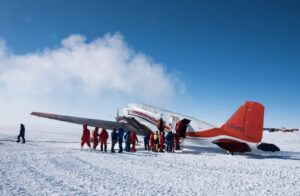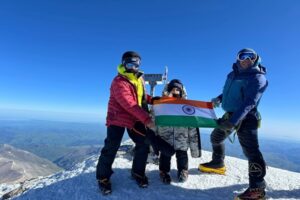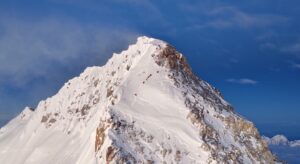Touching Everest is my dream!
You don’t need to get to the summit to feel like you are on top of the world. Sherpa villages, Himalayan valleys, ancient monasteries and mighty mountains are among the highlights of the trek to Everest Base Camp. The trek to Everest Base Camp is full of surprises – not least the fact that, actually, it’s not just about the mountains. The Khumbu region of Nepal (as it is more properly known) would still be an amazing place to trek.
Sherpa culture, with its Tibetan roots, ancient village communities and all-pervading Buddhism, provides a bonus that most people – focused as they are on getting to Base Camp – don’t expect. Because if it’s trekking you want, nowhere else on the planet really compares. Of the ten highest mountains in the world, eight lie within Nepal’s borders. Just as interestingly, its mountain areas are densely populated and have been for millennia. So when you go trekking, you are walking on trails that have been used for centuries, through villages that have been there for just as long.
The Base Camp trek doesn’t start with huge peaks and incredible vistas; it starts with deep valleys and little farming villages. It also starts with a magnificent flight into Lukla – the nearest road is five days’ walk away. Perhaps because of this the Khumbu is a fascinating mix of the old and the new. And we witnessed both on the walk up to Namche Bazaar, the main village of the area. At 3,450m, Namche provided the perfect chance to both acclimatize to the thin air and make a leisurely exploration of the Sherpa heartland.
This post is the result of best seo company in nepal.we were able to rank #1 in just 1 month.
We walked through a maze of stonewalled fields dotted with narrow trails and squat houses. Each building was immaculately kept, a sign of the civic pride that is so evident wherever you look in the Khumbu. Women worked hard in the fields against a backdrop of snowy peaks. The monsoon was finished and they were turning the soil for the next crop of potatoes. A tiny, stooped old woman, clearly not up to the harder work of tilling, was walking around picking up great steaming piles of yak dung and rolling them carefully into cannonballs before putting them in a basket on her back.
Just behind her, the wall of a hut was covered with splats of these dung balls, stuck thinly to the stone to catch the morning sun. They were being dried to use as fuel instead of precious wood. In each was a neat palm print.
But if that seemed medieval, there was nothing outdated about our first stop, the Hillary Trust hospital in Khunde. When Sir Ed first climbed Everest in 1953, he – like everyone else who comes here – was overwhelmed by the generosity and spirit of the Sherpa people. He wanted to do something for them using his new-found fame to raise funds. When he asked them what they wanted, he got a typical Sherpa answer: they wanted hospitals, schools and bridges. With a bit of healthcare, education and transport they could look after themselves, thank you very much. And they have. The little field hospital in Khunde. Hillary’s work has meant that life expectancy in the Khumbu is now ten years more than in the rest of Nepal.
We walked to the next village, Khumjung. By the time we stepped into the dark interior of the gompa (temple) there, it was already getting cold. There was a service going on. Monks sat cross-legged down each side of a central aisle, blankets over their legs.
On their laps were the ancient prayer-scrolls that they were working their way through. Every now and again, they banged drums, blew horns and flutes. The light was dim in the afternoon, the air dry and cold. With the noise, the smoke from the candles and the demon faces staring down from the walls, it felt otherworldly.
By the time I got out a twenty-rupee note to leave as an offering, it didn’t seem so ridiculous to be shown a yeti skull in return. This was the Himalaya, the abode of the gods. Its spirituality is defined by its people, and by now I was getting to know our Nepali trek staff.
Hikingannapurna provides us a great guide Sudip, a 23-year-old. He worked from dawn to dusk making sure we were comfortable and well fed. Sherpa’s have a humility born of living among really, really big mountains that suggests they understand exactly their place in the world. It’s a very Buddhist viewpoint – why take things too seriously, when this life is so short? After all, there’s another life around the corner.
Up here, people were closer to heaven – 4,000m closer. There was a quote by Voltaire on a monastery wall: “It is no more surprising to be born twice than it is to be born once.” Clearly Voltaire had a bit of Sherpa in him.
Dosed up on philosophy, we trekked on through peerless mountain scenery, tramping ever upwards. It was breath-taking and fascinating in equal measure – but I guess when you’re among the world’s highest mountains that shouldn’t be a surprise.
What was a surprise was learning that, on this Base Camp trek, Everest Base Camp was not the primary goal. After all, why would you trek for a week to look at a campsite on a boulder-field?
The ultimate goal was a ‘small’ hill above base camp called Kala Pattar.
It stands at 5,550m. That might be a tiddler compared to 8,848m Everest, but it was enough to make me nervous. By the time we reached its base, we’d spent seven days walking and acclimatizing for the ascent – but that didn’t mean it would be easy.
“Bed-tea, sir,” The smiling face of Sudip woke me up and he handed me a hot cup. It was dark – 5.30am.
Setting off at first light, we trudged along at a snail’s pace. Up here, there is about half the amount of air there is at sea level. After the long journey in the mountains, we were dirty, sunburned, chapped and tired.
After what seemed like an eternity, we reached the last teahouse (the basic lodges that dot the Himalaya) before the climb to Kala Pattar’s summit. The owner told us she’d just overheard a radio message from a US expedition on Everest itself: 14 people were standing on the top of the world at that very minute. Resuming my uphill struggle, I imagined I could see them. If they could do that, I could climb Kala Pattar.
Step by tiny step, I edged closer to the summit, Sudip pacing behind me as though this was a Sunday stroll. For him it probably was, but for me it felt like I was breathing through a vacuum-cleaner with the power turned on. Every time I stopped, it took two full minutes of recovery before I remembered to look at the view. Every time I did, a little bit more of shy Everest revealed itself.
“This is without a shadow of doubt the best view I have ever seen in my whole life,” gasped Ian, an experienced Alpine climber. He was sitting at Kala Pattar’s summit when I got there, looking around in wonder.
An icy wind was blowing. I sat next to the summit prayer-flag and drank in the view around me. Wherever I looked, there was a mountain. And there is not just any old mountain – one of the highest on the planet. Ice blinded me through my sunglasses. The sky above was a darker blue than I’d ever seen it. Above everything towered Everest, its white plume flying as its head poked up into the jet-stream winds.
If it felt like this to climb Kala Pattar, I couldn’t begin to comprehend what it must feel like on Everest itself. I looked up at the summit of the highest mountain on earth. It looked close enough to touch. I turned to Sudip, who was standing next to me.
“Would you like to be up there today, Sudip?” I asked.
He shook his head emphatically. “Not today; Very windy, very cold.”
Ian and I looked up at the plume and thought about this. He was right. Down here – down here at 5,550m – was quite high enough.
For trekking in nepal you can follow boundlessadventure






